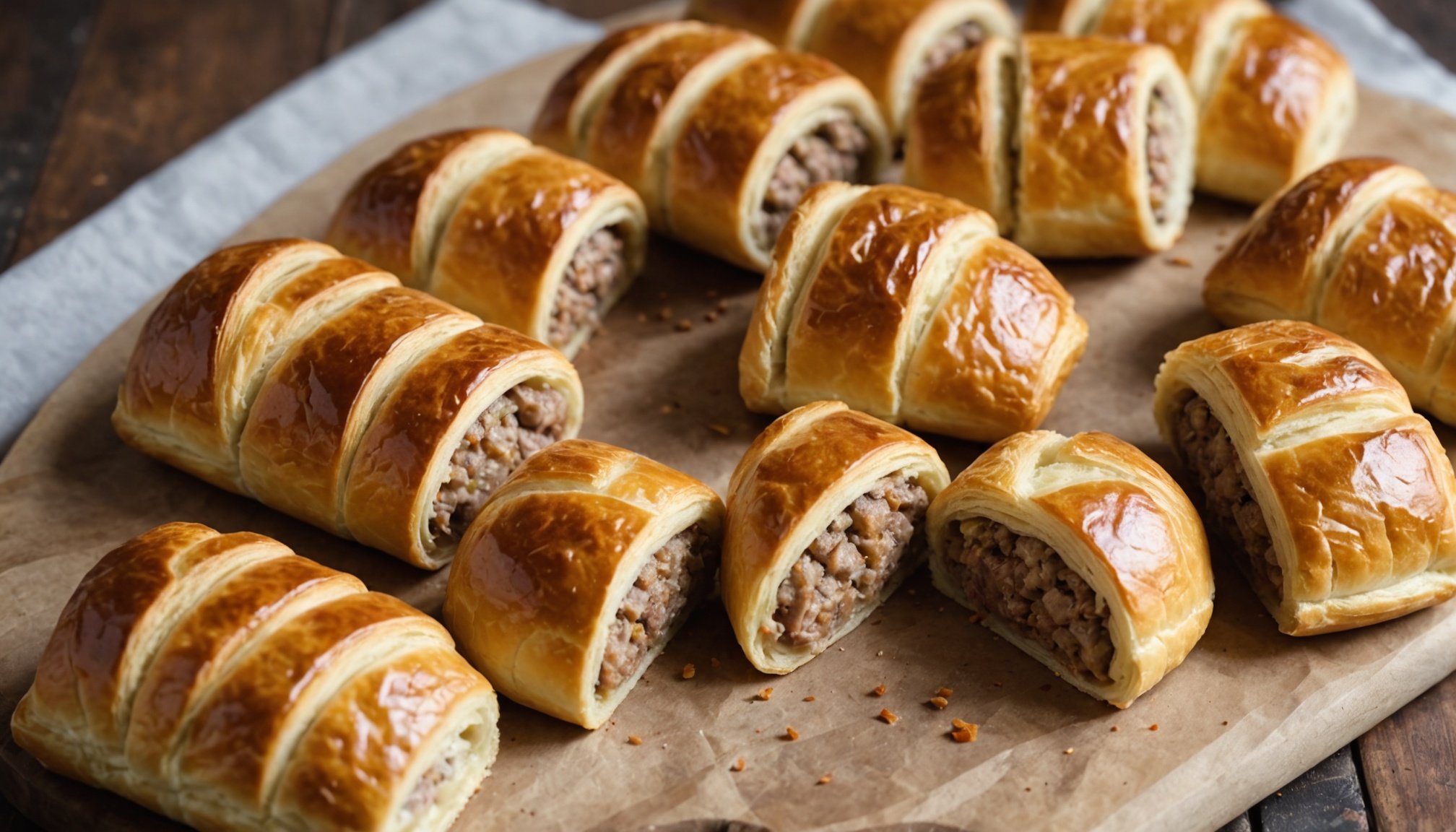Mastering the Art of Flaky and Buttery English Sausage Rolls: The Ultimate Guide
Understanding the Basics of Sausage Rolls
When it comes to English street food, few dishes are as beloved and iconic as the sausage roll. This flaky, savory treat has been a staple for centuries, and its appeal lies in its simplicity and versatility. To make a truly delicious sausage roll, you need to understand the core components: the pastry, the filling, and the cooking process.
The Pastry: Puff Pastry vs. Shortcrust Pastry
The pastry is the foundation of a good sausage roll. You have two main options: puff pastry and shortcrust pastry. Puff pastry, with its layers of butter and dough, is the more traditional choice for sausage rolls. It provides a flaky, golden brown crust that is both crispy and light.
In parallel : Unlock the Perfect Recipe for a Flavorful and Moist Spicy Christmas Cake!
| Pastry Type | Characteristics | Best For |
|
|----------------------------------|
|
| Puff Pastry | Flaky, layered with butter | Traditional sausage rolls |
| Shortcrust Pastry | Crumbly, less flaky | More rustic, homemade versions |
Puff pastry can be found in most supermarkets, either fresh or frozen. If you’re feeling adventurous, you can also make your own puff pastry from scratch, though this requires significant time and effort.
The Filling: Choosing the Right Sausage
The filling is where you can get creative, but traditional sausage rolls typically use pork sausage meat. Look for high-quality sausage meat with a good balance of fat and lean meat; this will ensure your rolls are juicy and flavorful.
Have you seen this : Unlocking the Art of Perfect English Scones with Luxurious Clotted Cream: Your Ultimate Guide
- Pork Sausage: The classic choice, pork sausage provides a rich, meaty flavor.
- Alternative Fillings: For a modern twist, you can use chicken, lamb, or even plant-based alternatives. Gourmet fillings like caramelized onion, apple, or chorizo can also add a unique flavor profile.
Preparing the Pastry and Filling
Before you start assembling your sausage rolls, you need to prepare both the pastry and the filling.
Preparing the Pastry
- Thawing: If using frozen puff pastry, thaw it according to the package instructions.
- Rolling: Roll out the puff pastry on a lightly floured surface to a thickness of about 1/8 inch.
- Cutting: Cut the pastry into long, thin rectangles, approximately 4 inches wide and 6 inches long.
Preparing the Filling
- Seasoning: Season the sausage meat with salt, pepper, and any other desired spices.
- Mixing: Mix the sausage meat well to ensure even distribution of the seasonings.
- Shaping: Shape the sausage meat into long, thin logs that match the size of your pastry rectangles.
Assembling and Baking the Sausage Rolls
Assembling the sausage rolls is a straightforward process, but it requires some care to ensure they turn out perfectly.
Assembling the Rolls
- Place the Filling: Place a sausage meat log in the center of each pastry rectangle.
- Brush the Edges: Brush the edges of the pastry with a little water or egg wash to help seal the roll.
- Roll and Seal: Roll the pastry over the filling, pressing the edges to seal. Use a fork to crimp the edges for a decorative touch.
Baking the Rolls
- Preheat the Oven: Preheat your oven to 400°F (200°C).
- Place on Baking Sheet: Place the sausage rolls on a baking sheet lined with parchment paper, leaving about 1 inch of space between each roll.
- Brush with Egg Wash: Brush the tops of the rolls with an egg wash (beaten egg mixed with a little water) for a golden brown finish.
- Bake: Bake for 20-25 minutes, or until the pastry is golden brown.
Tips and Variations
To take your sausage rolls to the next level, here are some tips and variations:
Tips for Perfect Sausage Rolls
- Keep the Pastry Cold: Cold pastry is easier to work with and will result in a flakier crust.
- Don’t Overfill: Leave a little space between the filling and the edges of the pastry to allow for expansion during baking.
- Use High-Quality Ingredients: High-quality sausage meat and fresh pastry will make a significant difference in the taste and texture.
Variations and Gourmet Twists
- Caramelized Apple and Onion: Add caramelized apple and onion to the sausage meat for a sweet and savory twist.
- Chorizo and Manchego: Use chorizo sausage and add some Manchego cheese for a Spanish-inspired flavor.
- Plant-Based Options: Use plant-based sausage alternatives and add ingredients like mushrooms or lentils for added texture and flavor.
Practical Insights and Actionable Advice
Making sausage rolls is a fun and rewarding process, but here are some practical insights to keep in mind:
Common Mistakes to Avoid
- Overworking the Pastry: Avoid overworking the pastry, as this can make it tough and dense.
- Underbaking: Make sure to bake the rolls long enough to get a golden brown crust.
Storage and Serving
- Freshness: Sausage rolls are best served fresh, but they can be stored in an airtight container for up to 2 days.
- Reheating: Reheat sausage rolls in the oven at 350°F (175°C) for about 10 minutes to restore their flaky texture.
Mastering the art of making flaky and buttery English sausage rolls is a journey that combines traditional techniques with modern creativity. Whether you’re using puff pastry or shortcrust pastry, and whether you opt for traditional pork sausage or gourmet fillings, the key to success lies in attention to detail and a passion for good food.
As Thomas Keller, renowned chef and author, might say, “The beauty of cooking lies in the simplicity and elegance of the ingredients and the technique.” When it comes to sausage rolls, this simplicity and elegance are what make them a timeless favorite in English cuisine.
So, the next time you’re in the mood for something delicious and comforting, take the time to make your own sausage rolls. With practice and patience, you’ll be creating golden brown, flaky, and buttery masterpieces that will impress anyone who tries them.











